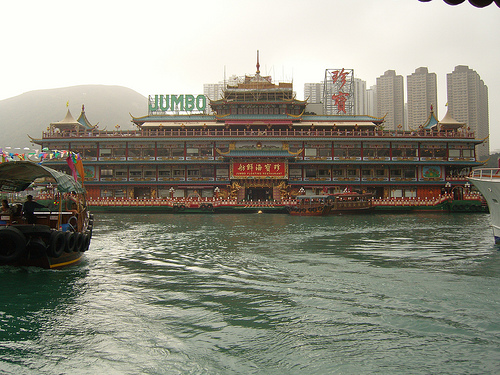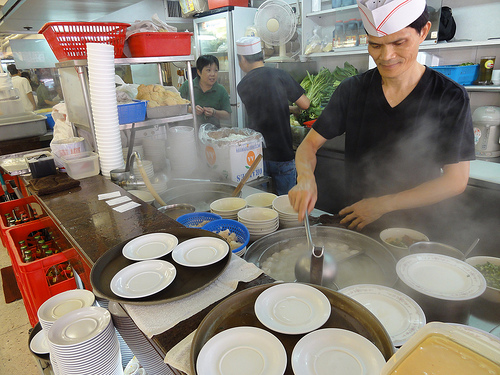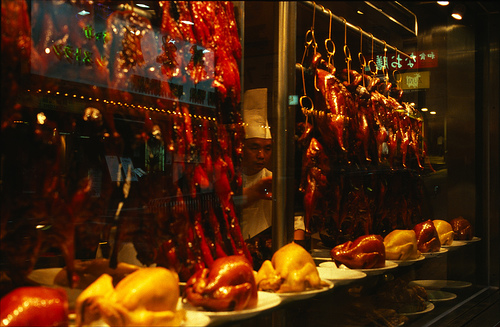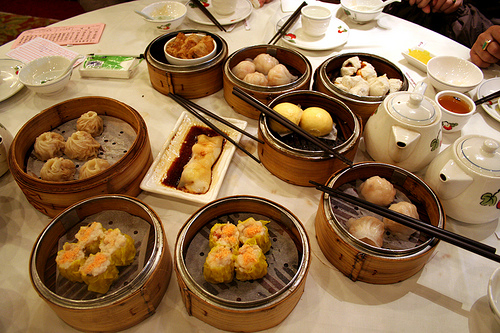Many of the best and oldest restaurants in Hong Kong are in the major hotels. And in our recommending them we are departing from our own gastronomic advice. We normally advise readers to avoid hotel restaurants. But for as long as Hong Kong has had hotels, fine eateries have been lodged within many of them. This is in part due to the fact that real estate is so expensive and always has been. Restaurants operate on profit margins so thin that even popular and successful establishments can go out of business overnight. But hotels, with their long-term leases, can weather the storms that often blow through the balance books.?An advantage to hotel dining is that all the service is rendered in the western style, and in English. The table settings are familiar, the waiter asks if you’d like a cocktail, the menu is readable, and the crystal and silver are finely polished. It’s all just like home, except that the food is better. If you’ve never been to Asia before, this is a good way to ease yourself in. And it’s a fine way to get yourself pampered.
There have always been western-style restaurants in Hong Kong, but they were always very traditional. Concept restaurants are, more than anything, reflections of the personalities of their owners. The concept may reflect where the owners come from, or it may reflect where they would like to have come from. It may be a place, a time or an era, an idea or a desire. They tend to be owned by North Americans, or people who have spent a lot of time in the US, Canada or Australia. Hence, English is the lingua franca. Some concept restaurants are simple and fun, some are dead chic, others are cosy and comforting.

Image by caspermoller
Identified by huge neon signs, neon restaurants are usually very spacious with high ceilings, and they are brightly lit and well ventilated. And it’s a joyous cacophony within. This is where Chinese people go most often when they go out to eat. The menus are very extensive, and most are Cantonese.?Most neon restaurants have at least one English speaker on duty at any given time. Quite often it’s the head waiter, so you’ll generally get pretty good, though utilitarian, service. On the outlying islands their counterparts are the outdoor seafood restaurants. They are basically neon restaurants that have swapped their neon signs for terraces facing the water. And the grandest neon restaurants in all Hong Kong are the floating restaurants on the south side of Hong Kong Island.
Dining in Hong Kong can get expensive. It can also be intimidating with such a wide variety of choice, and strange and unfamiliar venues and customs. And did we mention that it could get expensive? And so we patronise everyday low cost Chinese restaurants. This kind of restaurant is the soul of Chinese gastronomy: unpretentious, a bit earthy, a place of exuberance and life affirming noise.?This is a restaurant in the truest meaning of the word. It comes from the Latin verb meaning ‘to restore’, and this is where people come to be restored, in body and in spirit. The food is wholesome and plentiful. And all the hubbub, bustle and kitchen clatter serves to restore the spirit, to make one feel part of this greater whole.

Image by Kent Wang
Hong Kong would grind to a screeching halt if it woke up one day and found no?juk (congee; rice porridge) and no noodles. These eateries are found virtually everywhere that humans can be suffered to walk upon the ground. It’s Chinese fast food, comfort food and peasant fare all rolled into one.?Noodle and congee shops are almost always on the ground level, close to where life is taking place. We are not aware of any noodle shop on the top floor of a major hotel. They are most common in Kowloon, but you’ll find them anywhere there is foot traffic.

Image by tallkev
Chinese restaurants specialising in roasted or barbecued meats are common in Hong Kong. You’ll know them when you see them; they have all their wares hanging in the window. However, unlike a western steakhouse these are not places in which to indulge in mountainous portions of animal flesh. Indeed a typical meal at a Chinese roastery would be a very balanced one. A common lunch here might be a simple noodle soup garnished with a few slices of roast duck. A dinner might be comprised of vegetables, rice, soup and an ample portion of roast pork.?Of all the roasted meats available in Hong Kong the most popular is goose. The roast goose restaurants of Hong Kong are beloved by the people although, curiously, they are not as numerous as duck or pork roasteries.

Image by lookslikeamy
In the long view of Chinese culinary history, dim sum is a newcomer. A mere 1000 years old. Still, in this brief time the Chinese have managed to develop around 2,000 varieties of these morning and lunchtime treats. The larger yum cha houses will offer up to 100 items on any given day. You’ll be able to have dim sum every day of your stay in Hong Kong and not eat the same thing twice.?Eating in a yum cha house can be quite an experience.?In a traditional yum cha house there is no menu. Instead, ladies (they are always ladies) carry trays or push little trolleys laden with all the goodies. There is no succession of courses. There is no ‘this only goes with that’.?Your table will soon be piled high with steamer baskets and other containers, teapots, crumbs and spills.?In our opinion the best time for dim sum is 10-11am. If you come earlier or later, the noise, the rush for vacant seats, the chatter and clatter of waitresses pushing their trolleys, and the overall bustle can make the whole thing look like the New York stock exchange. On the other hand, maybe that’s your cup of yum cha.
The dai pai dong is usually a mobile concern that can flee the cops when they try to shut it down for being unlicensed. And they are an institution fast going the way of high tea and fish & chips, becoming a culinary fossil, albeit one of great sentimental value. They were visible at all hours, but especially after dark. They congregated in such numbers down by the waterfronts that the festive scene of dining, socialising, hawking of wares, juggling, magic or fortune telling was known as a poor man’s nightclub.
The term dai pai dong literally means ‘big licence food stall', and refers to the large sheet of paper on which their licence was printed. Sadly, in the 1980s the government stopped issuing these big licenses. Those licences still in existence are permitted to remain in business until the second generation. That is, the current licence holders can pass it on to their children, should they wish to make use of it. But when they expire, so does the big licence.
There are numerous unlicensed restaurants in Hong Kong and not all are dai pai dong. Many are proper sit-down places and are among the best in town. Just ask the government officials who are dining there. They tend not to invest much in decor, after all, such finery could end up in a police auction. But the food is magic. They are owned and operated by people who are in the business for the love of it. Often times the restaurateur is by day a broker, or a manufacturer of garments, or even a police officer. But by night they are the Scarlet Pimpernels of Clandestine Cuisine, bringing you their illicit best.
You have to know somebody to get into a speakeasy. You have to know somebody just to find one. But all serious gastronomes know a few. When you are invited you will be told to rendezvous at a secret location at a certain point in time. Do not be early. Do not be late. One of the cardinal rules of both espionage and illegal provender is punctuality. At the appointed hour people will emerge as one from the shadows, from behind bushes, from around corners, and converge upon a suddenly opened door. Now rush in, quickly, for the door must close before the cops cruise by.